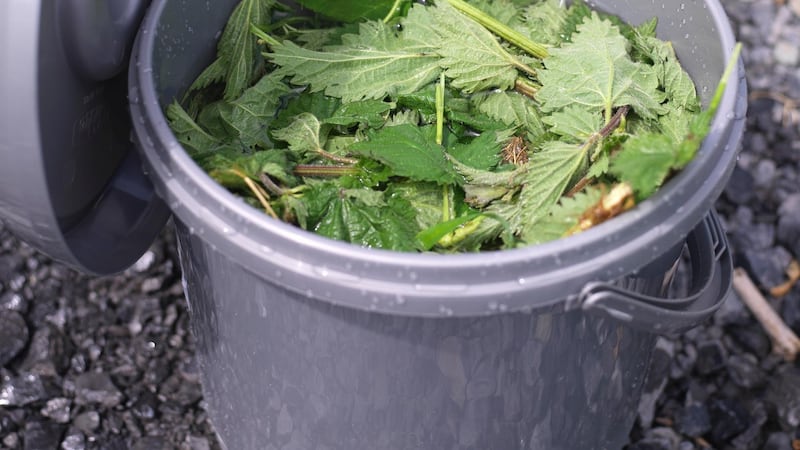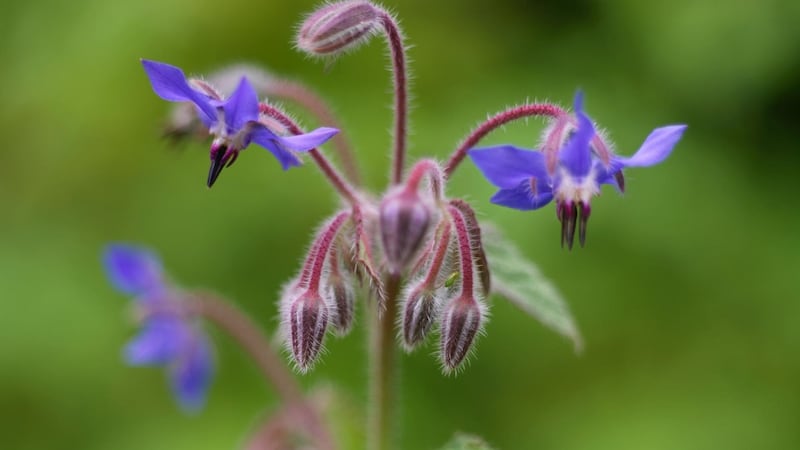“Grasp the nettle” goes the famous saying, and that’s exactly what I’ve been doing over the last week, albeit with my hands gloved and wielding a long-handled garden shears as an extra precaution against this wild perennial plant’s painful stings. Those tender young green leaves go straight into a large black plastic bin, after which I chop them up and cover them with a generous amount of water, topped with a lid (some eco-minded gardening friends swear by the addition of a little human urine at this stage, or “personal liquid waste” as it’s sometimes politely described, but that’s a step too far for me).
Left to stew for several weeks with just the occasional vigorous stir (hold your nose while doing so), this soupy mix will gradually transform itself into an oh-so-stinky but impressively effective, nutrient-rich, liquid plant feed. Last summer I gave it, diluted at a ratio of roughly one part feed to 10 parts water, to some invalid dahlias with remarkable results. Within a week the plants looked bigger, stronger and more vigorous, while it also dramatically helped their ability to resist slugs and other garden pests. As to the exact proportions of freshly harvested leaves to water, I’m never too strict about it, but aim for a rough ratio of one bucket of chopped leaves to 15-20 litres of water.
Planet-friendly
It’s not just my dahlias that are very glad of this nitrogen-rich plant tonic in early summer; a host of ornamental and vegetable plants – especially those that are container-grown – enjoy the many benefits. Best of all, this organic liquid feed is planet-friendly, meaning it does no harm to the environment or your garden’s ecosystem, which is a lot more than can be said for most modern synthetic fertilisers. Its only downside is its aforementioned ponginess, an aroma reminiscent of freshly sprayed farm slurry, a result of the anaerobic bacteria breaking down the leaves. This disappears quickly after a few showers of rain, but to avoid the liquid accidentally touching your hands or your clothing, it’s best to wear rubber gloves and boots when applying it.

The humble nettle isn’t the only plant whose leaves can be transformed into a nutrient-rich liquid plant feed in this way. The very same goes for the leaves of borage (especially rich in nitrogen) and comfrey (especially rich in potassium, so excellent for encouraging flowers /fruit formation). If a binful of concentrated feed is too much for your needs, scale the production down by using a plastic bucket or even a two-litre plastic drinks bottle upturned with its base cut off. But whatever container you decide to use, make sure to cover it with a lid (or, in the case of the plastic bottle, with some cling film) to contain its odoriferousness.
Non-smelly
Alternatively, you can also make a non-smelly, more concentrated comfrey feed by collecting the leaves and placing them into a container on their own without any added water. The treacly brown liquid produced can be stored in a bottle and diluted for use when required.

Yet another common weed suitable for making a nutrient-rich liquid plant feed is the silica-rich horsetail (Equisetum arvense), a native wild plant that many Irish gardeners dread for its invasive qualities. "Equisetum tea" is especially good at protecting seedlings and plants against common fungal plant diseases such as "damping-off" and powdery mildew. In its case, you'll need to simmer a bowlful of its strangely prehistoric-looking stems in hot water for about 20 minutes and then leave it to cool, before straining off the liquid and bottling it. Used in diluted form, it can be applied as a fortnightly foliar feed or root drench. If you can't get your hands on fresh horsetail, then chamomile tea has a similar anti-fungal effect on plants.
Fresh seaweed
Although technically an algae rather than a plant, fresh seaweed is yet another plant-like organism that’s remarkably rich in nutrients, and which can be used to make an excellent foliar spray (a spray that’s applied to the leaves/ stems of a plant). Not only does it stimulate growth, boost germination rates and help with root establishment, but it also boosts soil health. Just make sure to harvest it sustainably from unpolluted beaches and with respect for local bylaws (harvest only small amounts washed up on the shore rather than live seaweed growing on rocks, unless you have what are known as “turbary rights”). Again, it’s a simple matter of putting the chopped-up seaweed in a container, covering it with water, sealing it with a lid and leaving it to stew. To use it, dilute the resulting liquid with water until it’s the colour of weak tea, making sure to use it in its most diluted form on young seedlings.

Nettles, comfrey, borage, horsetail, chamomile and seaweed aside, it’s worth pointing out that the leaves of many other common wild and cultivated plants are rich in macro and micro plant nutrients. Indeed, many of them, just like horsetail, are among our most hated weeds. Scutch grass, for example, is rich in potassium and silica, while dandelion leaves are rich in iron. So try adding a few of them to the pot – or bin/bucket, in this case. You’ll be pleasantly surprised by how much they’ll play their part in helping your choicest garden plants stay healthy and happy.
THIS WEEK IN THE GARDEN
If you live in one of the milder, coastal regions of the country, then now is a good time to start planting up summer containers (those with colder gardens should hold off for another couple of weeks). While there are a host of gorgeous, summer-flowering plants suitable for creating seasonal displays – examples include argyranthemums, pelargoniums, heliotropes, salvias, fuchsias, compact varieties of dahlias and cosmos, perennial geraniums – don't forget to add some foliage interest for a truly satisfying result. Suitable examples of the latter include the silver, woolly-leaved Helichrysum petiolare and Plectranthus argentatus as well as many ornamental grasses.
There are some tall or heavy-flowered perennial plants such as delphiniums, asters, phlox and oriental poppies that need careful staking or some other form of support (twiggy branches, metal hoops, netting, chicken wire cages) to prevent their stems from falling over or breaking in a strong wind or a heavy rain shower. The trick is to do it now before any damage is done and while plants are still making enough vigorous growth to quickly conceal the ugly evidence.

If you're lucky enough to grow it as a crop, then you'll know that it's asparagus season in the garden. To harvest these succulent, vitamin-rich spears correctly, use a sharp knife to carefully cut them about 5-7cm below ground when they're about 12-18cm long, making sure to avoid damaging any emerging spears as well as the roots of the plants. Some gardeners like to use a knife with a curved, serrated blade specially designed for this purpose (available from Mr Middleton, €8.95, see mrmiddleton.com)
DATES FOR YOUR DIARY
Tuesday, May 23rd-Saturday, May 27th: the RHS Chelsea Flower Show 2017 with show gardens by leading garden designers including James Basson and Chris Beardshaw, and exhibits by some of the world's best plant nurseries, floral artists and horticultural suppliers; ticket availability is now very limited, see rhs.org.uk; Tuesday May 23rd (8pm): Foxrock Parish Pastoral Centre, 18 Kill Lane, Dublin 18, Plain Jane or Supermodels, a talk by nurseryman Bob Brown of Cotswold Garden Flowers on behalf of Foxrock and District Garden Club; event open to all, see foxrockgardenclub.com. Saturday, May 27th: (10.30am-1.30pm), Altamont Walled Garden, Ballon, Co Carlow, Container Planting with Hester Forde, a half-day course in creating a wonderful container-grown display of flowers, grasses and foliage for your garden or patio. Cost: €25 including morning coffee and materials.




















